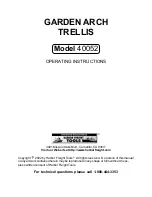
Page 36
8.8 PREPARING THE POOL WATER
Installer please note - When properly sized to the site, the Digital Nano/Nano+ will meet the sanitizer
“maintenance” requirements of the pool/spa. The Digital Nano/Nano+ is not designed to chlorine shock
treat, or build up a chlorine residual, when starting with a zero or very low chlorine level.
Before starting the Digital Nano/Nano+, the water must be properly balanced, and the chlorine level
must be adjusted to between 1 to 3 ppm (mg/L) free chlorine. More on adjusting water balance, and
start-up chlorine levels, follows below.
8.8.1
Steps to Prepare Water
1) Calculate pool volume. See section 8.8.2.
2) Adjust water chemistry. Add chemicals to adjust pool or spa water chemistry parameters as
indicated in the table in section 3.5,
“Water Balance and Chemistry Recommendations” on
page 7. The saturation index can be calculated using the information in section 10.2,
” on page 51. If the index indicates that the pool water is corrosive or
scaling then adjustments to the water chemistry should be made.
3) Add initial chlorine dosage. Use sufficient chlorine as obtained from pool supply center, to
achieve 1-3 ppm (mg/L) free chlorine.
4) Add salt to water (test the water for salt level first). Adjust to 3,000
– 4,500 ppm (mg/L). See
“Salt Addition Chart” on page 52.
5) Enter pool volume information into the Digital Nano/Nano+.
programming on page 23.
8.8.2
Calculating Pool Volume
To determine the approximate number of gallons or liters in a pool or spa:
1) Determine the surface area.
2) Multiply the surface area by the average depth and the constant conversion factor of 7.5
to convert cubic feet to gallons or 1,000 to convert from cubic meters to liters
Rectangle
Area = Length x Width
Gallons = area x average depth
(ft
3
)
x 7.5
Liters = area x average depth
(m
3
)
x 1,000
Circular
Area = Radius x Radius x 3.14
Gallons = area x average depth
(ft
3
)
x 7.5
Liters = area x average depth
(m
3
)
x 1,000
To determine the approximate number of gallons or liters in a more complex shaped pool:
1) Divide the complex shape into several simple shapes.
2) Calculate each one separately, and then add back together.
Example: An oblong pool can be divided into two radius measurements and one
rectangular shape. (R = Radius)
Area
= Radius x Radius x 3.14 + (Length x Width)
Gallons = area x average depth
(ft
3
)
x 7.5
Liters
= area x average depth
(m
3
)
x 1,000
















































